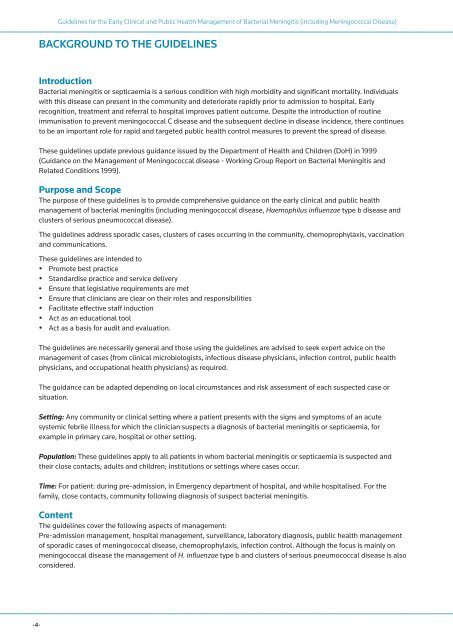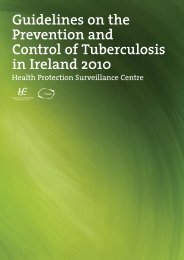Guidelines for the Early Clinical and Public Health Management of ...
Guidelines for the Early Clinical and Public Health Management of ...
Guidelines for the Early Clinical and Public Health Management of ...
You also want an ePaper? Increase the reach of your titles
YUMPU automatically turns print PDFs into web optimized ePapers that Google loves.
<strong>Guidelines</strong> <strong>for</strong> <strong>the</strong> <strong>Early</strong> <strong>Clinical</strong> <strong>and</strong> <strong>Public</strong> <strong>Health</strong> <strong>Management</strong> <strong>of</strong> Bacterial Meningitis (including Meningococcal Disease)<br />
Background to <strong>the</strong> guidelines<br />
Introduction<br />
Bacterial meningitis or septicaemia is a serious condition with high morbidity <strong>and</strong> significant mortality. Individuals<br />
with this disease can present in <strong>the</strong> community <strong>and</strong> deteriorate rapidly prior to admission to hospital. <strong>Early</strong><br />
recognition, treatment <strong>and</strong> referral to hospital improves patient outcome. Despite <strong>the</strong> introduction <strong>of</strong> routine<br />
immunisation to prevent meningococcal C disease <strong>and</strong> <strong>the</strong> subsequent decline in disease incidence, <strong>the</strong>re continues<br />
to be an important role <strong>for</strong> rapid <strong>and</strong> targeted public health control measures to prevent <strong>the</strong> spread <strong>of</strong> disease.<br />
These guidelines update previous guidance issued by <strong>the</strong> Department <strong>of</strong> <strong>Health</strong> <strong>and</strong> Children (DoH) in 1999<br />
(Guidance on <strong>the</strong> <strong>Management</strong> <strong>of</strong> Meningococcal disease - Working Group Report on Bacterial Meningitis <strong>and</strong><br />
Related Conditions 1999).<br />
Purpose <strong>and</strong> Scope<br />
The purpose <strong>of</strong> <strong>the</strong>se guidelines is to provide comprehensive guidance on <strong>the</strong> early clinical <strong>and</strong> public health<br />
management <strong>of</strong> bacterial meningitis (including meningococcal disease, Haemophilus influenzae type b disease <strong>and</strong><br />
clusters <strong>of</strong> serious pneumococcal disease).<br />
The guidelines address sporadic cases, clusters <strong>of</strong> cases occurring in <strong>the</strong> community, chemoprophylaxis, vaccination<br />
<strong>and</strong> communications.<br />
These guidelines are intended to<br />
• Promote best practice<br />
• St<strong>and</strong>ardise practice <strong>and</strong> service delivery<br />
• Ensure that legislative requirements are met<br />
• Ensure that clinicians are clear on <strong>the</strong>ir roles <strong>and</strong> responsibilities<br />
• Facilitate effective staff induction<br />
• Act as an educational tool<br />
• Act as a basis <strong>for</strong> audit <strong>and</strong> evaluation.<br />
The guidelines are necessarily general <strong>and</strong> those using <strong>the</strong> guidelines are advised to seek expert advice on <strong>the</strong><br />
management <strong>of</strong> cases (from clinical microbiologists, infectious disease physicians, infection control, public health<br />
physicians, <strong>and</strong> occupational health physicians) as required.<br />
The guidance can be adapted depending on local circumstances <strong>and</strong> risk assessment <strong>of</strong> each suspected case or<br />
situation.<br />
Setting: Any community or clinical setting where a patient presents with <strong>the</strong> signs <strong>and</strong> symptoms <strong>of</strong> an acute<br />
systemic febrile illness <strong>for</strong> which <strong>the</strong> clinician suspects a diagnosis <strong>of</strong> bacterial meningitis or septicaemia, <strong>for</strong><br />
example in primary care, hospital or o<strong>the</strong>r setting.<br />
Population: These guidelines apply to all patients in whom bacterial meningitis or septicaemia is suspected <strong>and</strong><br />
<strong>the</strong>ir close contacts; adults <strong>and</strong> children; institutions or settings where cases occur.<br />
Time: For patient: during pre-admission, in Emergency department <strong>of</strong> hospital, <strong>and</strong> while hospitalised. For <strong>the</strong><br />
family, close contacts, community following diagnosis <strong>of</strong> suspect bacterial meningitis.<br />
Content<br />
The guidelines cover <strong>the</strong> following aspects <strong>of</strong> management:<br />
Pre-admission management, hospital management, surveillance, laboratory diagnosis, public health management<br />
<strong>of</strong> sporadic cases <strong>of</strong> meningococcal disease, chemoprophylaxis, infection control. Although <strong>the</strong> focus is mainly on<br />
meningococcal disease <strong>the</strong> management <strong>of</strong> H. influenzae type b <strong>and</strong> clusters <strong>of</strong> serious pneumococcal disease is also<br />
considered.<br />
-4-

















